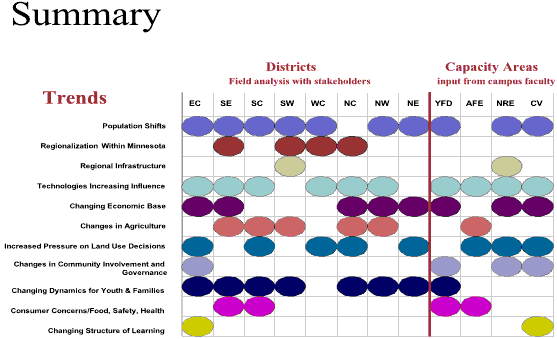October 2002 // Volume 40 // Number 5 // Ideas at Work // 5IAW1
Creating the Base for Extension Priority Issues
Abstract
Field and campus faculty partnered in
a trend analysis process that established a baseline
of trends and resulting issues important to Minnesotans
over the next 3 years. Approximately 70% of the
trends and issues identified resulted from both
the field and the discipline process. This congruence
launched a program-development process mobilizing
the organization around 14 critical issues. Work
teams are currently identifying Extension's niche
with these issues, and staff development, resources,
and expertise are being leveraged for appropriate
local response.
Trend Analysis
Two years ago the University of Minnesota Extension Service initiated a trend analysis process. The goal of the analysis was twofold: collect data that would launch a program development process and, in doing so, build relationships and create linkages within the new program development system. We moved from 10 Specializations supporting field and campus faculty work to four Capacity Areas: Agriculture Food and Environment, Youth and Family Development, Natural Resources and Environment, and Community Vitality.
Redistricting the state from five districts to eight created smaller geographic areas for District Directors. With smaller districts, district directors' responsibility was expanded to include program development as well as administration.
We hoped the assessment data collected from the Districts and through the Capacity Areas would verify similar trends and issues for Extension to consider in program planning. A 70% overlap was anticipated, establishing a baseline of trends and issues field and campus faculty would use in a statewide program planning process. In the past, program-planning processes were conducted at various times by units within Extension. This was the first time field and campus faculty were engaged collectively in an organization-wide process.
The Process
Each team collected and synthesized secondary data relevant to their district or discipline. They accessed state and regional data provided by the Minnesota Planning Agency, Regional Development Commissions, Center for Rural Policy and Development, Minnesota Agriculture Statistics, and various county departments such as Public Health and Family Social Services. They worked with University of Minnesota coordinate campuses, Agricultural Experiment Branch Stations (Research and Outreach Centers), Regional Sustainable Partnerships, and the Minnesota State Colleges and Universities. Non-profits such as United Way and The Children's Defense Fund also had applicable research.
The information was organized under "The Eight Dimensions of a Healthy Community," a framework The Blandin Foundation uses in their Community Investment Partnership Program. After organizing the data, teams engaged stakeholders in conversation around key questions. The questions stimulated discussion regarding the data and their implications for the economy, environment, and quality of life.
Engaging the Public
Teams were encouraged to be inclusive of diverse stakeholders as they engaged people. We encouraged engaging residents from various locations in the district and a sector balance of agriculture, business, government agencies, education, health care, organizations, and nonprofits. We sought balance in gender, race/ethnicity, age, disability, and social/economic backgrounds.
After civic engagement, teams prioritized five trends and issues affecting Minnesotans over the next 3 years. We defined trend as a change or shift in the context in which we live and work, and an issue as a situation of wide public concern resulting from a trend.
Organizing Results
Teams submitted their findings, and Capacity Area Leaders and District Directors worked with the Organization and Program Development Specialist to organize and frame the summary.
Eleven trends and resulting issues were highlighted at the Program Summit, held October 10, 2000. This presentation is available at <http://www.extension.umn.edu/administrative/reporting/trendsummary/>. The following chart illustrates the trend as it appeared in the District and Capacity Area assessments.

Priority Issues
450 field and campus faculty collectively identified priority issues based on the trend analysis. Faculty left the 2-day Summit having identified 14 priority issues and four ways of working important to the entire organization.
The following priority issues were named, understanding most of the priority issues reside in more than one Capacity Area. The Capacity Area named will provide leadership for convening a multi-disciplinary team.
Youth and Family Development (YFD)
- Positive Out of School Time
- Building Family Strengths
- Vital Aging
Community Vitality (CV)
- Working with Changing Communities
- Community Governance, Leadership and Civic Engagement
- Technological Literacy and Proficiency
- Community Economics
Agriculture, Food and Environment (AFE)
- Biotechnology and Food Safety
- Farm Business Management
- Horticulture
Natural Resources and Environment (NRE)
- Leadership for Land Use and Water Quality
- Safe Healthy and Affordable Housing
- Economic Opportunity from Natural Resources
- Connecting People to Natural Resources Through Education (a.k.a. Evaluation of NR Programming)
Four Ways of Working Important to the Entire Organization
- Seek inclusivity/diversity
- Foster civic engagement and informed action on public issues
- Engage youth as resources
- Accessing and use technology
After the Program Summit, Capacity Area Teams honed Extension's niche within the priority issues. District teams wrote their plans of work based on the district analysis and Capacity Area program priorities.
An evaluation process to monitor the statewide program development system is being created. It is imperative we identify learnings and make needed course corrections to assure the infrastructure and process created support program development. We will measure results against the goals initially set:
- Focused, high-quality programming
- Effective mobilization around critical issues
- Flexible and adequate program resources
- Efficient use of time and energy
- Accountability for impact
In Summary
Field and campus faculty conducted a trend analysis process that established a baseline of trends and issues important to Minnesotans over the next 3 years. The congruence in trends and issues launched a program-development process mobilizing the organization around 14 critical issues. This process provided the basis for the Minnesota plan of work, inclusive of the federal plan--the work we will be held accountable for doing.
